Khan Academy- AP gov unit 1
Key terms
term | definition |
Constitutional Convention | It was also known as the Philadelphia Convention. It was a meeting of delegates from 12 of the 13 states to revise or replace the Articles of Confederation with a new Constitution featuring a stronger central government. |
limited government | A political system in which the government’s power is restricted by laws or a written Constitution. |
natural rights | The right to life, liberty, and property, which no government may take away. |
republicanism | The principle of governing through elected representatives. |
social contract | An agreement between people and government in which citizens consent to be governed so long as the government protects their natural rights. |
People to know
person | Contribution |
John Adams | Massachusetts statesman and leader in the movement for American independence. Adams aided Jefferson in drafting the Declaration of Independence. |
Ben Franklin | Pennsylvania statesman and leader in the movement for American independence. Franklin aided Jefferson in drafting the Declaration of Independence. |
Alexander Hamilton | New York statesman who promoted replacing the Articles of Confederation with a stronger central government. He coauthored the Federalist Papers, which argued in favor of ratifying the Constitution. |
Thomas Jefferson | Principal author of the Declaration of Independence. |
James Madison | Virginia statesman and major contributor to the US Constitution. He coauthored the Federalist Papers and wrote the Bill of Rights. |
George Washington | Revolutionary War general who presided over the Constitutional Convention. |
Important documents
The Declaration of Independence - This document explains the reasons why the Thirteen Colonies in North America desired independence from Great Britain. The ideals for government expressed in the Declaration, including popular sovereignty and social contract, serve as the inspiration for American democratic values.
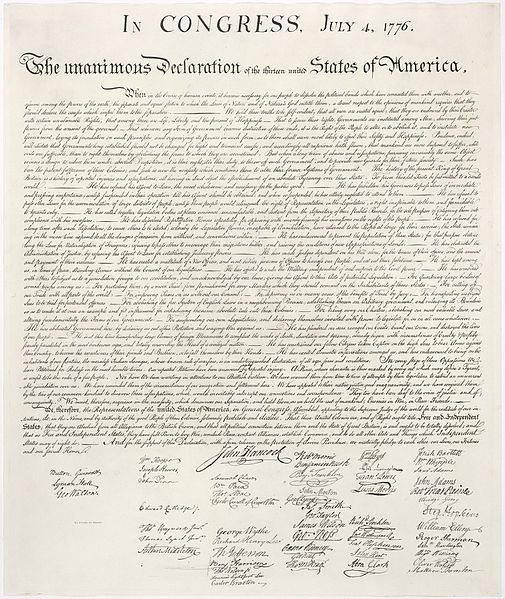
The Declaration of Independence. Image credit: Wikipedia
Quote to know:
“We hold these truths to be self-evident, that all men are created equal, that they are endowed by their Creator with certain unalienable Rights, that among these are Life, Liberty and the pursuit of Happiness.”
The US Constitution - The Constitution is a blueprint for how American government functions. Establishes the three separate branches of the US government (legislative, executive, and judicial) and describes the relationship between the states and the federal government. It demonstrates the principle of limited government in the United States by restricting the powers of government. It also establishes the principle of republicanism by establishing the process for citizens to elect representatives to the legislature.
Quote to know:
“We the People of the United States, in Order to form a more perfect Union, establish Justice, insure domestic Tranquility, provide for the common defense, promote the general Welfare, and secure the Blessings of Liberty to ourselves and our Posterity, do ordain and establish this Constitution.”
Key takeaways from this lesson
Balancing liberty and order: From the beginning, the US government has attempted to balance individual rights and liberties with the government power necessary to, as the Constitution puts it, “establish justice, insure domestic tranquility, [and] provide for the common defense.”
The Declaration of Independence served as a statement of the Founders’ beliefs in natural rights and individual liberties. With the Constitution, the early American statesmen attempted to build a government that was strong enough to sustain itself without infringing on citizens’ rights and liberties.
Review questions
What are natural rights? How would you describe them in your own words?
How are the Declaration of Independence and the Constitution similar? How are they different?
When creating the Constitution, one of the major questions facing the Framers was how to create a strong central government with the power to rule over its citizens without infringing upon citizens’ liberties. Foundational documents like the US Constitution, Federalist No. 10, and Brutus No. 1 illustrate the debate over this balance.
Key terms
TermDefinition | |
democracy | A system of government in which the power of the government is vested in the people, who rule directly or through elected representatives. |
participatory democracy | A form of democracy that emphasizes broad, direct participation in politics and civil society, in which most or all citizens participate in politics directly. |
pluralist democracy | A form of democracy in which political power rests with competing interest groups so that no one group dominates political decisions. |
elite democracy | A form of democracy in which a small number of people, usually those who are wealthy and well-educated, influence political decision-making. |
Key documents to know
Federalist No. 10 — An essay written by James Madison, in which he argued that a strong representative government would be able to control the effects of factions.
Brutus No. 1 — An Anti-Federalist essay that argued against a strong central government based on the belief that it would not be able to meet the needs of all US citizens.
Constitution (1787) — The fundamental laws and principles that govern the United States. The document was the result of several compromises between Federalists and Anti-Federalists surrounding the ratification of the Constitution.
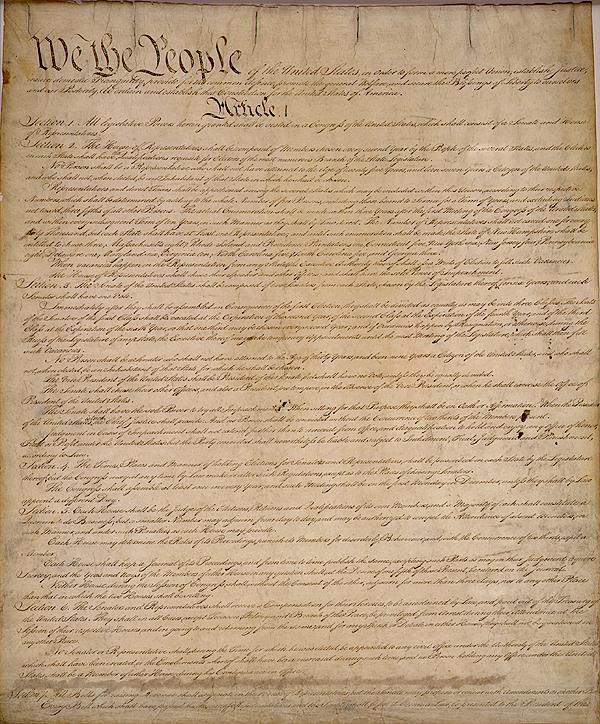
The US Constitution. Image credit: Wikimedia Commons
Important takeaways
Participatory democracy in action: Participatory democracy (sometimes called direct democracy) is the idea that everyone should be, and can be, involved in politics. It emphasizes broad participation in politics and encourages ordinary people —not just a small subset of the population— to be responsible for political decisions.
An example of participatory democracy in the United States today is the use of referenda in some states. Referenda aallowscitizens to have a direct vote on a particular law. A referendum is an example of participatory democracy because the citizens themselves (not their government representatives) are the ones who decide whether to enact that law.
Pluralist democracy in action: Pluralist democracy is the idea that policymaking is open to lots of groups who have different interests. Each of these groups has the potential to influence policymaking, but no one group dominates all political decisions.
An example of pluralist democracy in the United States today is the participation of interest groups like the National Rifle Association (NRA) and Global Green USA. Both of these groups raise funds for candidates, promote candidates, and strive to influence current members of Congress on political decisions. Interest groups are an example of pluralist democracy because citizens join groups to influence policymakers, rather than having direct access to political decisions.
Elite democracy in action: An elite democracy is one in which a small subset of citizens makes political decisions. Those who make policy are usually wealthier and more educated than the average citizen. In an elite democracy, those who are in power are highly qualified to make political decisions.
An example of elite democracy today is the Electoral College. The Electoral College is used in presidential elections and determines the outcome of most elections. Under this system, a candidate might win the popular vote in an election (meaning more citizens voted to elect them than their opponent), but lose the electoral vote, and thus the presidency. The Electoral College is intended to provide a check on voters and act as a safeguard in case the voters make an unwise decision.
Review questions
Which model of democracy does Federalist No. 10 describe? How do you know?
Which model of democracy does Brutus No. 1 describe? How do you know?
Based on what you've learned, construct an argument for which type of democracy you think creates the most stable form of government that is run by the people.
The Articles of Confederation formed the first governing system of the United States of America, which linked the states during the turbulent years of the American Revolution. Under the Articles of Confederation, which linked the states in a ‘loose league of friendship,’ the central government had no power to tax or to compel individual states to abide by its decisions.
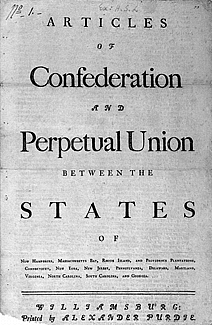
The Articles of Confederation. Image credit: Library of Congress
After the Revolutionary War, a series of problems, including economic problems, disputes between states, and an armed rebellion, made it clear that the United States needed a stronger central government to address its challenges.
Key terms
TermDefinition | |
Articles of Confederation | The first government system of the United States, which lasted from 1776 until 1789. The Articles placed most power in the hands of state governments. Government under the Articles lacked an executive or a judicial branch. |
Confederation Congress | The central government under the Articles of Confederation, was composed of delegates chosen by state governments. Each state had one vote in the Congress, regardless of its population. The Congress had difficulty legislating as the Articles required nine of the thirteen states to vote to approve any measure and a unanimous vote to amend the Articles themselves. |
Shays' Rebellion | An uprising of Revolutionary War veterans in Massachusetts, who had not been paid for their military service as the federal government lacked the power to raise funds through taxation. Led by veteran Daniel Shays, the rebellion demonstrated the weaknesses of the federal government under the Articles, as it could neither raise the money to pay the veterans nor raise an army to put down the uprising. |
Problems of the Articles of Confederation
ProblemConsequence | |
The national government could not tax citizens directly, only request money from the states. | The states rarely contributed money, meaning the national government could not pay its debts or fund initiatives. |
The national government could not regulate international or interstate trade. | The national government could not stop states from undermining it by making their trade agreements with foreign nations. |
The national government could not raise an army and only requested that the states send soldiers. | States could refuse to send soldiers, making it difficult to defend the nation. |
Each state only had one vote in Congress, regardless of its population. | The citizens of small states had proportionally more political power than the citizens of large states. |
The national government had no executive branch. | The national government had no way of implementing or enforcing its legislative decisions. |
The national government had no judicial branch. | There was no effective way to resolve disputes between states, such as competing claims to the same territory. |
Passing laws required the approval of nine states, and amending the Articles required the approval of all thirteen states. | It was difficult to get enough consensus to make laws and nearly impossible to fix the Articles themselves. |
Key takeaways from this lesson
The first draft of a constitutional government: The Articles of Confederation were the first national constitution, which outlined the structure, functions, and limitations of the US government. This “first draft” of a constitution demonstrated that the new United States government would be both a republic (a government of elected representatives) and a limited government (restricted by laws).
The weak central government established in the Articles made a lot of sense during the American Revolution when it brought together a group of former colonies to coordinate a war against the government of Great Britain, which the American patriots perceived as far too powerful. Although the Articles ultimately proved unequal to the task of governing the country after the Revolution, they were an important first step toward the current US Constitution.
Balancing state and national power: The Articles of Confederation created a national governing system that placed most power in the hands of the states. The Founders feared giving too much power to a central government, which might become tyrannical. But they overdid it, leaving a central government that could not fund itself, resolve disputes between its component states, or defend the country.
In the Constitutional Convention, delegates from the states would attempt to address these weaknesses while still limiting the power of government.
Review questions
Name three major problems of the Articles of Confederation, and explain the implications of those problems.
In what ways was the governmental system established in the Articles of Confederation similar to Uthe S government today? In what ways was it different?
When crafting the new constitution that would replace the Articles of Confederation, the Framers had to answer an important question: What type of government would be strong enough to enforce order, but not so strong that it would violate the personal liberties of American citizens?
Federalists and Anti-Federalists wrote several essays on the matter, each group advocating for a different structure of government.
Key terms
TermDefinition | |
Articles of Confederation | The first government system of the United States, which lasted from 1776 until 1789. The Articles placed most power in the hands of state governments. Government under the Articles lacked an executive or a judicial branch. |
Confederation Congress | The central government under the Articles of Confederation, was composed of delegates chosen by state governments. Each state had one vote in the Congress, regardless of its population. The Congress had difficulty legislating as the Articles required nine of the thirteen states to vote to approve any measure and a unanimous vote to amend the Articles themselves. |
Key documents to know
Federalist No. 10 — An essay written by James Madison, in which he argues that a strong central government will control the effects of factions.
Brutus No. 1 — An Anti-Federalist essay that argued against a strong central government, based on the belief that it would not be able to meet the needs of all US citizens.
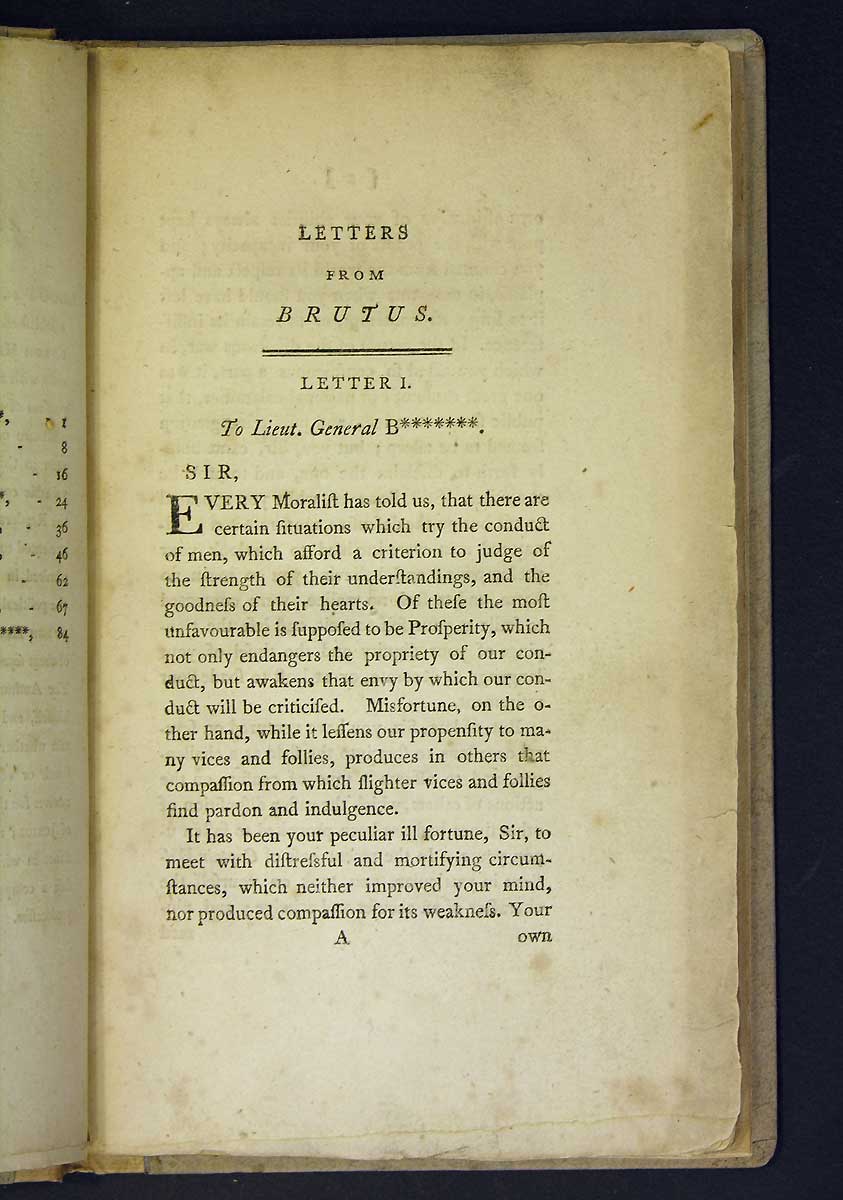
The first page of Brutus No. 1. Image credit: Reading Revolutions
Key takeaways from this lesson
Limited government in the Constitution: The Articles of Confederation had several weaknesses that made governing difficult. These weaknesses caused delegates to meet in Philadelphia to discuss replacing the Articles of Confederation with a Constitution that created a stronger central government. Anti-Federalists, or people who were against ratifying the Constitution, feared that a strong central government would lead to tyranny and not reflect people’s needs.
The debate between Federalists and Anti-Federalists led to several compromises that created a blueprint for a limited government, in which the Constitution limits the federal government's power.
Who has the power: the states or the federal government? Federalist No. 10 and Brutus No. 1 show how Federalists and Anti-Federalists had different opinions on how strong the federal government should be.
In Federalist No. 10, Madison argued that a large republic could control the “mischiefs of faction” and evenly distribute power between the federal government and the states.
The author of Brutus No. 1 disagreed, arguing that a powerful, centralized government was too far removed from individual citizens to meet their needs.
This debate about the proper role and strength of the federal government still exists today, as seen in issues like the role of the federal government in public school education.
Review questions
How does the Constitution create a limited government?
What are the advantages of a large central government, as described in Federalist No. 10?
What are the disadvantages of a large central government, as explained in Brutus No. 1?
The US Constitution emerged from the debate about weaknesses in the Articles of Confederation and was the product of important compromises over issues of representation and the power of the federal government.
Although the Constitution was eventually ratified, debates over the role of the central government, the powers of state governments, and the rights of individuals remain at the heart of present-day constitutional issues.
Key terms
TermDefinition | |
amendment | A change to the United States Constitution. |
Article V | The section of the Constitution details how to amend the Constitution, either through a congressional proposal or a convention of the states, with final ratification from three-fourths of the states. |
Great Compromise | Also known as the Connecticut Compromise, a major compromise at the Constitutional Convention that created a two-house legislature, with the Senate having equal representation for all states and the House of Representatives having representation proportional to state populations. |
Electoral College | A body of representatives from every state in the United States who formally cast votes to elect the president and vice president. |
Three-Fifths Compromise | An agreement was added to the Constitution that would count each enslaved person as three-fifths of a white person for purposes of representation in the House of Representatives. |
Key documents to know
US Constitution (1787) — The fundamental laws and principles that govern the United States. The document was the result of several compromises between Federalists and Anti-Federalists surrounding the ratification of the Constitution.
The amendment process
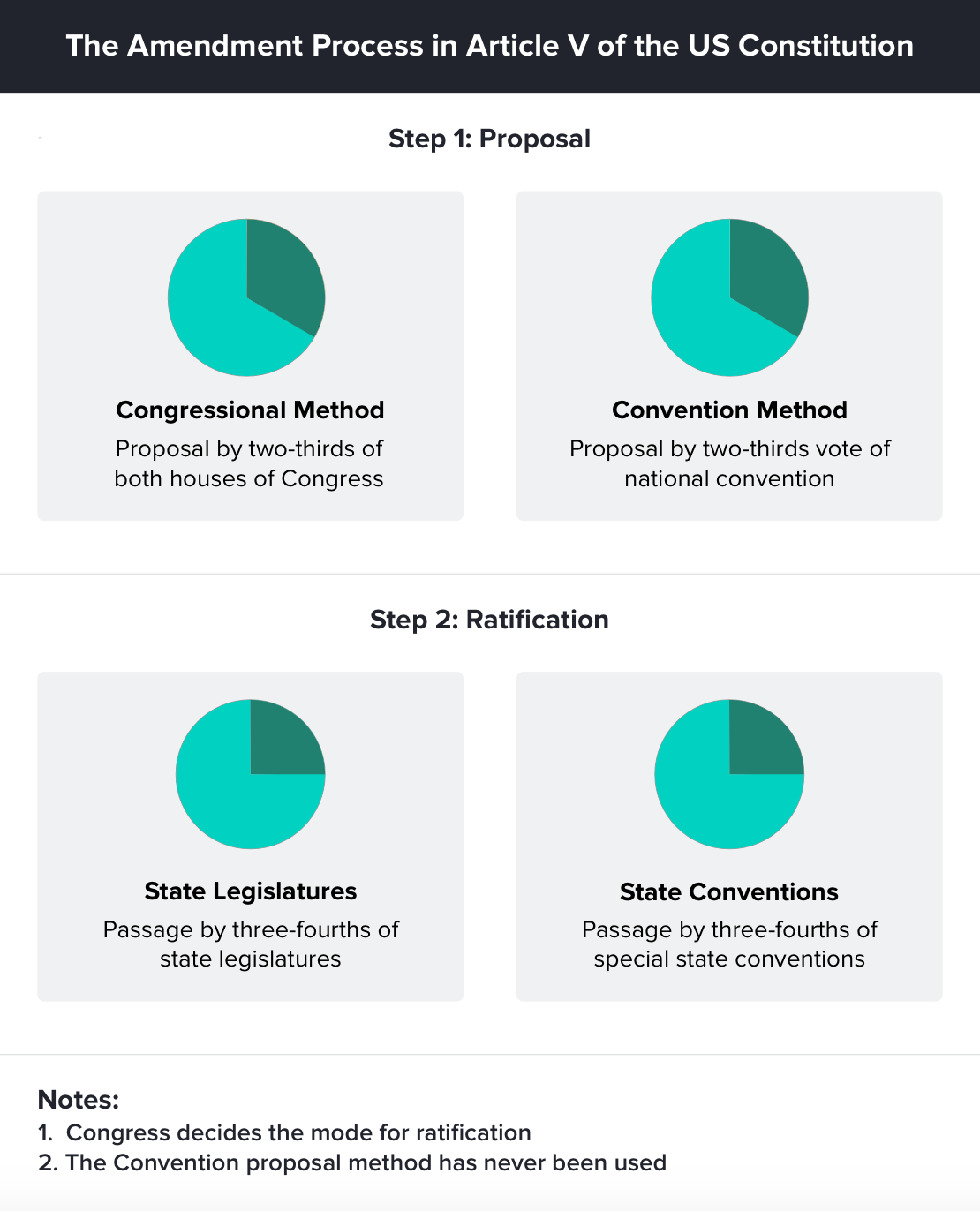
Important takeaways
Compromises at the Constitutional Convention: When the Articles of Confederation proved to be an ineffective form of government for the United States, delegates from 12 of the 13 states met in Philadelphia. To get the Constitution ratified by all 13 states, the delegates to the Constitutional Convention had to reach several compromises.
The three major compromises were the Great Compromise, the Three-Fifths Compromise, and the Electoral College. The Great Compromise settled matters of representation in the federal government. The Three-Fifths Compromise settled matters of representation when it came to the enslaved population of southern states and the importation of enslaved Africans. The Electoral College settled how the president would be elected.
Matters unresolved in the Constitution today: Although these compromises secured ratification of the Constitution, they also left some matters unresolved.
For example, the Great Compromise satisfied both small and large states, but there are questions today about whether the Senate's representation should be based on population, as in the House of Representatives. Differences in population growth have brought into question whether two senators per state are fair to states with large populations.
The Electoral College system has also led to controversy. In both the election of 2000 and the election of 2016, one candidate won the popular vote, but the other candidate won the Electoral College and therefore the presidency. Critics charge that in this system, a small group of representatives decides the presidency, rather than the entire population of the United States, and that states with smaller populations have a disproportionate say in who becomes president.
Constitutional debates that exist today: Even today, some of the issues at the heart of the debates at the Constitutional Convention still exist. Some of these questions include: How strong should the federal government be? What powers do the states have? 3) Which individual rights are protected? These debates surface in issues like the federal government’s surveillance of US citizens following the attacks on September 11th and the role of the federal government in public school education.
Review questions
How did the compromises necessary to secure ratification resolve issues in the Articles of Confederation?
How did Article V of the Constitution resolve a weakness of the Articles of Confederation?
The US Constitution creates a complex, competitive policymaking processtoo ensure that the people’s will is represented and that freedom is preserved. It does this by separating powers among the three branches of government and between the federal government and state governments, as well as making sure that no one part of government can get too powerful through checks and balances in the policymaking process.
Key terms
TermDefinition | |
access point | A point in the policymaking process where ordinary citizens can influence government. |
checks and balances | Aspects of the Constitution require each branch of the federal government to gain the consent of the other two to act. |
faction | An interest group seeking to influence government for the benefit of its members. The Framers sought to prevent any one faction from gaining too much power. |
majority | The largest group that shares an opinion on any one issue, for example, whether to declare war or support a tax. |
minority | A smaller group with a differing opinion on any one issue. The Framers sought to keep majority opinions from trampling minority opinions. |
impeachment | The bringing of formal charges against a government officer for alleged crimes or abuses of power. |
removal | Removing a government officer from office after impeachment proceedings resulted in a conviction. |
separation of powers | Aspects of the Constitution ascribe different elements of power to different branches of the government, which act independently. This keeps one branch of government from controlling the others. |
stakeholder | A person with an interest or a concern in a political issue. |
Important documents
Federalist No. 51 — An essay written by James Madison (under the pseudonym Publius) explains how the structure of the new government under the Constitution will provide the necessary checks and balances to keep any part of the government from becoming too powerful.
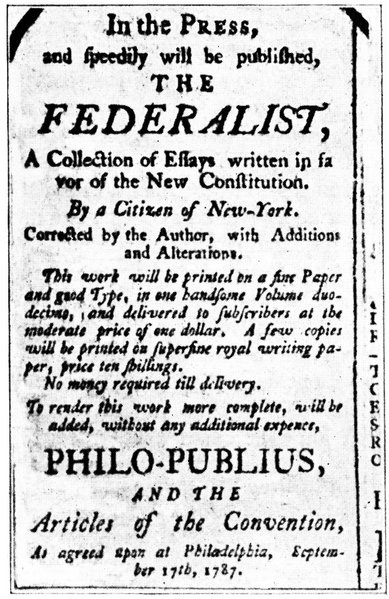
Advertisement for the Federalist Papers. Image credit: Wikimedia Commons
Madison argues that because people are naturally self-interested, separating the powers of government into distinct and independent branches will require them to compete with one another to govern, therefore limiting the power of the government as a whole.
Quote to know:
“What is government itself, but the greatest of all reflections on human nature? If men were angels, no government would be necessary. If angels were to govern men, neither external nor internal controls on government would be necessary. In framing a government which is to be administered by men over men, the great difficulty lies in this: you must first enable the government to control the governed; and in the next place oblige it to control itself.”
Key takeaways
Complex policymaking processes: The structure of the US government established in the Constitution purposely makes policymaking complicated, requiring various branches, institutions, and individuals to work together to accomplish goals.
The Constitution also provides solutions for indicting (impeaching), and if necessary removing, individuals who commit crimes or abuse their powers in office. These measures help to ensure that the people’s will is represented by permitting many people to influence the policymaking process, as well as preserving freedom by limiting the power of government.
Review questions
Describe the concept of ‘checks and balances’ in your own words. Why are checks and balances important to the US government system?
Describe ‘separation of powers’ in your own words. Why is separating powers among the branches of government important?
What is James Madison’s argument in Federalist No. 51? How did his ideas, as expressed in Federalist No. 51, influence the structure of the US government?
What’s the difference between impeachment and removal?
Government in the United States is shared between local, state, and federal governments. The distribution of power between state and national governments has changed over time in response to societal needs.
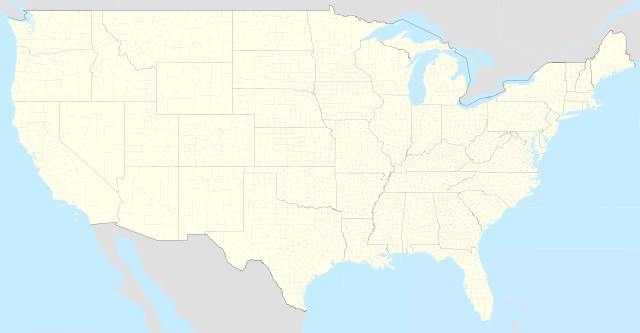
Map of the United States, including state and county boundaries. Image credit: Wikimedia Commons
Key terms
TermDefinition | |
block grants | Federal grants issued to states or local governments to support broad programs |
categorical grants | Federal grants restricted to specific purposes |
concurrent powers | Powers shared by the federal government and state governments, e.g. lawmaking and taxation |
exclusive powers | Powers reserved either to the federal government or state governments |
federalism | Political system that organizes government into two or more levels with independent powers; in the United States this consists of local, state, and national governments |
federal revenue sharing | The practice of sharing federal income tax revenue with state and local governments |
mandate | A requirement that states or local governments meet a specific condition to receive federal aid |
Document to know
The US Constitution: Articles IV and V of the US Constitution outline the federal system used in the United States today.
Article IV establishes that the states will give “full faith and credit” to the laws of other states. For example, if a citizen gets legally married in one state, he is still married if he moves to another state. Likewise, if a citizen commits a crime in one state, she cannot escape to another state and evade justice. States also can’t discriminate against citizens of other states if they move; any US citizen who moves to a state is entitled to the same “privileges and immunities” of citizenship in that state as someone born there.
Article IV also promises states the protection of the federal government. It does this by promising to defend states against invasion, guaranteeing them a republican form of government, and barring the federal government from splitting up a state without the consent of its legislature and Congress.
Article V describes the process of amending the Constitution, which requires the ratification of three-quarters of the states. This provision of the Constitution demonstrates the importance of the states in approving the workings of the US government.
Exclusive and concurrent powers of state and federal governments
Exclusive federal powersConcurrent powersExclusive state powers | ||
Coining money | Taxation | Conducting elections |
Regulating interstate and foreign commerce | Lawmaking and enforcement | Establishing local governments |
Regulating the mail | Chartering banks and corporations | Providing for public safety, health, welfare |
Declaring war | Taking land for public use (eminent domain) | Maintaining militia |
Raising armies | Establishing courts | Ratifying Constitutional amendments |
Conducting foreign affairs | Borrowing money | Regulating intrastate commerce |
Establishing inferior courts | ||
Establishing rules of naturalization |
Key takeaways
Constitutional allocation of power: In addition to the separation of powers and system of checks and balances that guard against any one branch of the federal government becoming too powerful, federalism separates the powers of the federal and state governments as an added security measure to reign in government power. The federal system grants states large autonomy over lawmaking within their borders, so long as they do not violate citizens’ rights or contradict federal laws. The federal government is also able to assert power over the states through grants and mandates.
This system allows local state governments to be responsive to the particular needs of their citizens while binding the states together into a larger nation.
Review questions
Name one power exclusive to the federal government and one power exclusive to state governments. Now, name two concurrent powers shared by both state governments and the federal government.
Why is the American system of government divided into three levels? What is the impact of the federal system on US policymaking?
Why are certain powers reserved for different levels of government? Can yougeneralizet the kinds of powers reserved to the federal government vs. the kinds of powers reserved to state governments?
Federalism is the distribution of power between the federal government and state governments. However, the Constitution does not create clear-cut lines for which types of policy fall under each level of government.
This has led to questions over the balance of power between national and state governments. The appropriate distribution of power has been interpreted differently over time. At some points, measures have been taken to enhance federal power, while at other points, the Framers, and later, the Supreme Court, have enhanced state power.
Key terms
TermDefinition | |
commerce clause | Part of Article I of the Constitution gives Congress the power to regulate interstate commerce (buying and selling of goods across state lines). |
federalism | An institutional arrangement that creates two relatively autonomous levels of government, each possessing the capacity to act directly on behalf of the people with the authority granted to it by the national constitution. |
enumerated powers | Powers of the federal government that are explicitly named in the Constitution. |
implied powers | Powers of the federal government that are not explicitly named in the Constitution but are implied so that the federal government can carry out its enumerated powers. |
necessary and proper clause | Part of Article I of the Constitution gives Congress the power to create laws that they find “necessary and proper” for performing their constitutional responsibilities. |
Tenth Amendment | Constitutional amendment that stipulates that all powers not given to the federal government are reserved to the states or the people. |
Fourteenth Amendment | Constitutional amendment that grants citizenship, equal protection, and due process under the law to all people born in the United States. |
Enumerated vs. implied powers
What's the difference between enumerated and implied powers, and why should we care?
Here's a real-world example: Say that your parents tell you that they'll pay for you to get ice cream with your friends. Awesome!
You make a plan with your friends, wait for the bus to head downtown, pay the fare, ride to the ice cream shop, get ice cream, and come back by the bus. When you get home, you tell your parents that the ice cream cost you $5 and the bus fare came to $4, so you need $9, please.
Your parents respond, "We only said we'd pay for ice cream! We didn't say we'd pay for you to get to the ice cream shop. We only owe you $5."
But how could you have gotten ice cream with your friends if you couldn't get to your friends? Well, maybe you could have bought a half-gallon of ice cream and invited your friends over . . . although you still would have had to go to the grocery store to do that, too. Is it even possible to get ice cream without going through some other step?
This is the essence of enumerated vs. implied powers: enumerated powers are those things that the Constitution explicitly says Congress can do (in Article I): levy taxes, regulate commerce with other nations, borrow and coin money, establish post offices, raise an army, and declare war, among other things.
But Article I also says that Congress shall have the power to "make all Laws which shall be necessary and proper for carrying into Execution the foregoing Powers." From this "necessary and proper clause" Congress argued that it had implied powers to do those things necessary to achieve its enumerated powers. For example, if Congress has the power to coin money, it's implied that Congress has the power to set up mints and pay workers to run those mints. In McCulloch v. Maryland, the Supreme Court confirmed that Congress can exercise these implied powers.
Although this seems pretty straightforward, it gets more difficult to decide just what counts as an implied power if you consider how to define "necessary." What if when your parents said they'd pay for you to get ice cream with your friends, you deemed it necessary to rent a helicopter to fly to the ice cream shop in style? Was that necessary, or was that just taking advantage of the opportunity? This conflict over the limits of federal power continues today.
Key documents to know
Constitution (1787) — The fundamental laws and principles that govern the United States. The document resulted from several compromises between Federalists and Anti-Federalists in the Constitutional Convention.
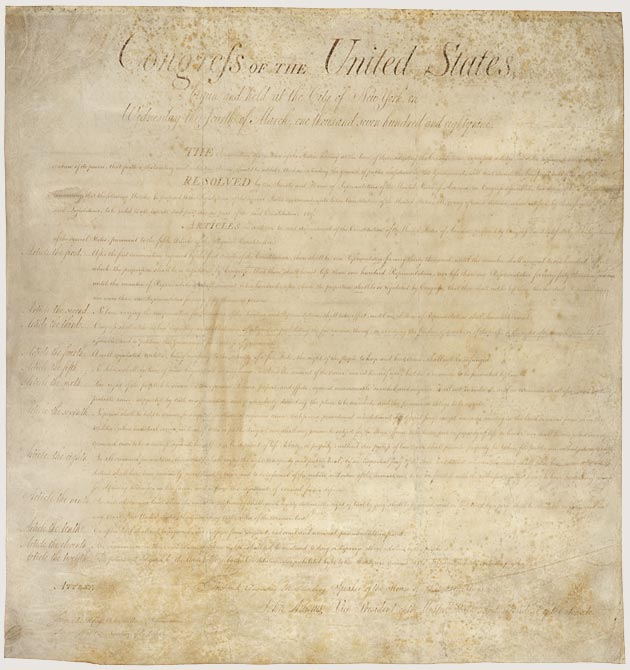
The Bill of Rights. Image credit: National Archives
Key cases to know
McCulloch v. Maryland (1819) — Supreme Court case that guaranteed the supremacy of federal laws over state laws and declared that Congress has implied powers not listed in the Constitution to fulfill their enumerated powers.
US v. Lopez (1995) — Supreme Court case which stopped Congress from using the commerce clause to ban guns in schools
Key takeaways from this lesson
Questions about federalism: Federalism refers to the distribution of power between the federal government and the state governments. The Constitution sketches a federal framework that aims to balance the forces of decentralized and centralized governance in general terms. However, the Constitution does not flesh out standard operating procedures that say precisely how the states and federal governments are to handle all policy contingencies imaginable.
Therefore, officials at the state and national levels have had some room to maneuver as they operate within the Constitution’s federal design. This has led to changes in the configuration of federalism over time, changes corresponding to different historical phases that capture distinct balances between state and federal authority.
Enhancing federal power: When the Constitution was ratified, there were still debates between the Federalists and the Democratic-Republicans in Congress about how much power the federal government should have.
Interpretations of particular clauses in the Constitution have led to an increase in federal power over time. The necessary and proper clause gives the federal government power to create laws that they deem “necessary and proper,” while the commerce clause gives the federal government power over interstate commerce.
In McCulloch v. Maryland (1819), the Supreme Court ruled that the federal government had implied powers to fulfill the duties of their enumerated powers. Later, the federal government enhanced its power over the states by passing the Fourteenth Amendment, which prevented the states from infringing on the rights of individuals.
Enhancing state power: Concerns over a strong central government motivated Anti-Federalists to argue for the inclusion of a Tenth Amendment in the Bill of Rights. The Tenth Amendment guaranteed that all powers not granted to the federal government are state powers.
In United States v. Lopez (1995), the Supreme Court ruled that the federal government had infringed on states’ rights by passing the Gun-Free Schools Act and the federal government could not ban guns in schools. Although the federal government argued that the power to ban guns in schools fell under the Commerce Clause, the Supreme Court disagreed and claimed the law was unconstitutional as it violated the Tenth Amendment.
Review questions
What constitutional arguments has the Supreme Court used to enhance or limit federal power over time?
What is the difference between enumerated and implied powers?
How did the Fourteenth Amendment give the federal government more power over the states?
Unit Overview
This unit introduced some of the foundational ideas of the US government, and the origins of debates about government that remain with us today. For example, what is the best way to preserve individuals’ rights and liberties while still maintaining order in society? Should everyone participate in government, or just the highly educated or wealthy? How much power should the government have, and how can we keep government power from getting out of hand? Which level of government should have the most power: the states or the federal government?
These questions, and the shifting answers to them over time, form the basis of political debate in the American government.
Key terms from this unit
TermDefinition | |
checks and balances | Aspects of the Constitution require each branch of the federal government to gain the consent of the other two to act. |
commerce clause | Part of Article I of the Constitution gives Congress the power to regulate interstate commerce (buying and selling of goods across state lines). |
Electoral College | A body of representatives from every state in the United States who formally cast votes to elect the president and vice president. |
enumerated powers | Powers of the federal government that are explicitly named in the Constitution. |
faction | An interest group seeking to influence government for the benefit of its members. |
federalism | A political system that organizes government into two or more levels with independent powers. |
implied powers | Powers of the federal government that are not explicitly named in the Constitution but are implied by the “necessary and proper” clause. |
limited government | A political system in which the government’s power is restricted by laws or a written Constitution. |
natural rights | The right to life, liberty, and property, which no government may take away. |
necessary and proper clause | Part of Article I of the Constitution gives Congress the power to create laws that they find “necessary and proper” for carrying out its constitutional responsibilities. |
separation of powers | The aspect of the Constitution ascribes different elements of power to different branches of the government, which act independently. |
social contract | An agreement between people and government in which citizens consent to be governed so long as the government protects their natural rights. |
Key documents and cases from this unit
Articles of Confederation — The first government system of the United States, which lasted from 1776 until 1789. The Articles placed most power in the hands of state governments.
Bill of Rights — The first ten amendments to the US Constitution, explicitly protected individual liberties such as freedom of speech.
Brutus No. 1 (1787) — An Anti-Federalist essay, which argued against a strong central government based on the belief that it would not be able to meet the needs of all US citizens.
Constitution (1787) — The fundamental laws and principles that govern the United States.
Federalist No. 10 (1787) — An essay written by James Madison, which argued that a strong representative government would be able to control the effects of factions.
Federalist No. 51 (1788) — An essay written by James Madison that explained how the structure of the new government under the Constitution would provide the necessary checks and balances to keep the government from becoming too powerful.
McCulloch v. Maryland (1819) — A Supreme Court case that guaranteed the supremacy of federal laws over state laws.
US v. Lopez (1995) — A Supreme Court case that stopped Congress from using the commerce clause to ban guns in schools.
Key takeaways from this unit
The birth of the Constitution: The first government system of the United States, the Articles of Confederation, had a weak national government due to concerns about centralized power stemming from the American colonies’ experiences with the British monarchy. The US Constitution sought to remedy the weaknesses of the Articles without giving the central government so much power that it would become tyrannical. Passing the Constitution, however, required many compromises, such as the inclusion of the Electoral College and a dual system of representation in Congress. These compromises have had far-reaching consequences that still affect the government in the United States today.
Balancing state and federal power: The proper balance of power between the federal government and state governments has been a source of ongoing negotiation since the beginning. In some instances, federal power has been enhanced at the expense of state power, such as the ruling in the case McCulloch v. Maryland that federal laws are supreme over state laws. But federal power is limited, and the Supreme Court has also ruled that the government has overstepped its authority in cases such as US v. Lopez.
Balancing liberty and order: From the beginning, the US government has attempted to balance individual rights and liberties with the government power necessary to, as the Constitution puts it, “establish justice, insure domestic tranquility, [and] provide for the common defense.” The Framers passed the Bill of Rights after the ratification of the Constitution as a safeguard for individual liberties.
Complex policymaking processes: The structure of the US government established in the Constitution purposely makes policymaking complicated, requiring various branches, institutions, and individuals to work together to accomplish goals. It deliberately places parts of government at odds with one another so that they rein each other in. These measures help to ensure that the people’s will is represented by permitting many people to influence the policymaking process, as well as preserving freedom by limiting the power of government.
Review questions
What aspects of the US government, as described in the foundational documents, promote individual liberty? What aspects promote order and public safety?
Name three measures the Framers took to ensure that government power is limited and that the people’s will is carried out.
Which of the compromises made at the Constitutional Convention do you think was the most important? Why?
Did the Framers intend for ordinary people or for elites to have more influence in government? Provide two pieces of evidence to support your position.
The balance of power between the federal government and state governments has shifted over time. What caused those shifts? Do you think the balance of power at present is shifting more toward the states or ttowardthe federal government? Why?
 Knowt
Knowt